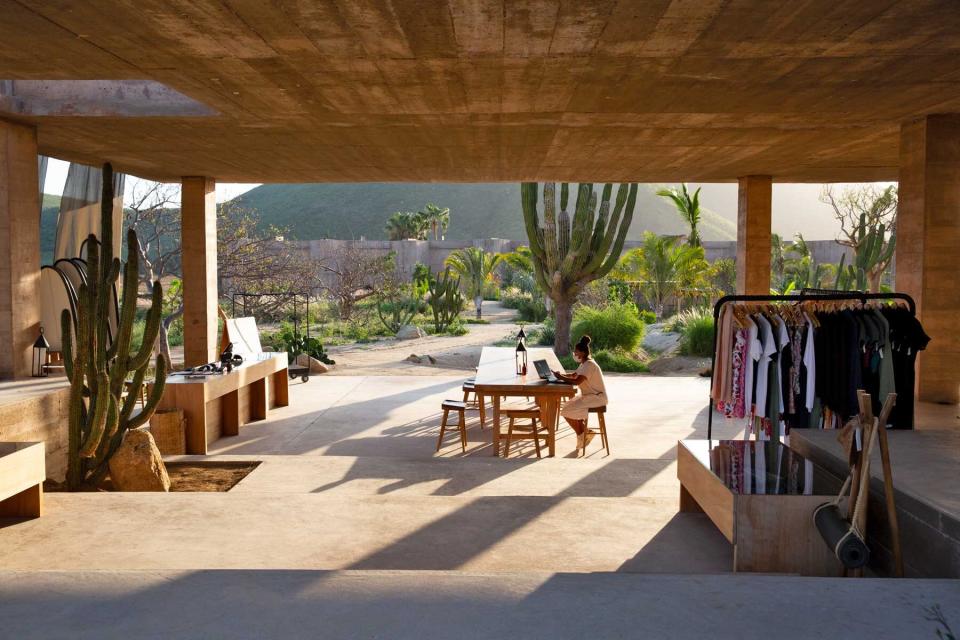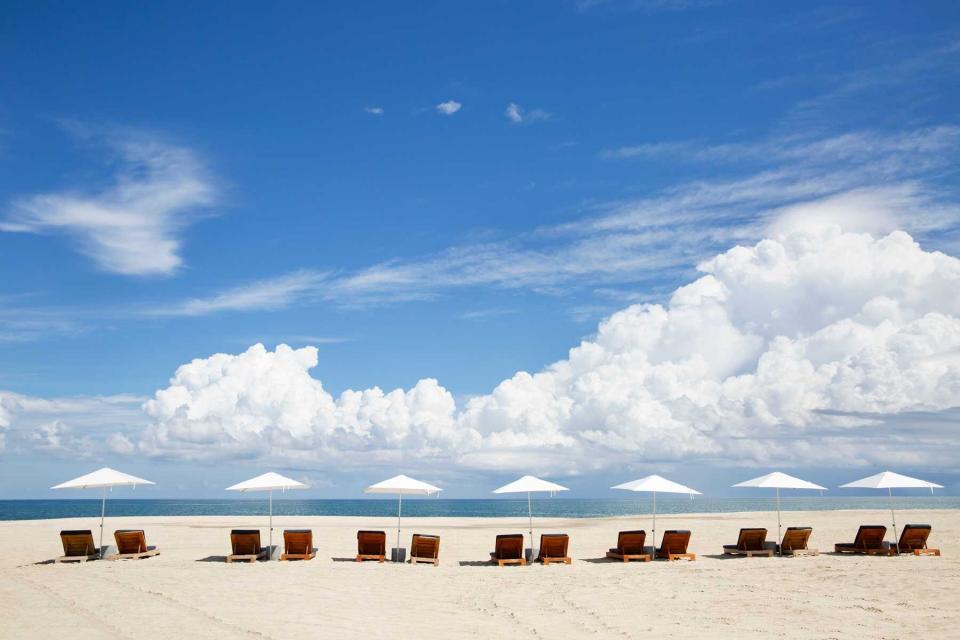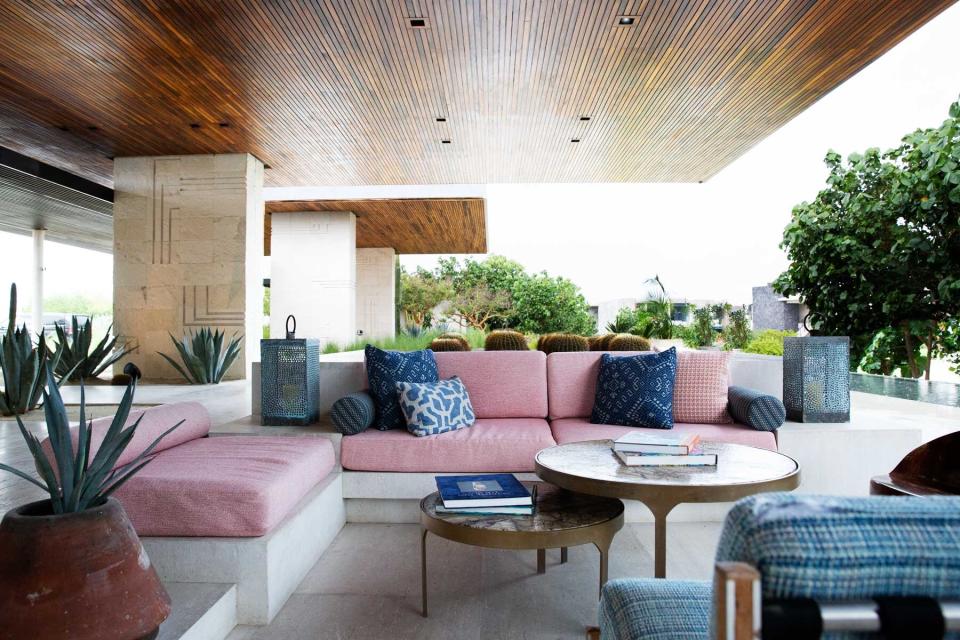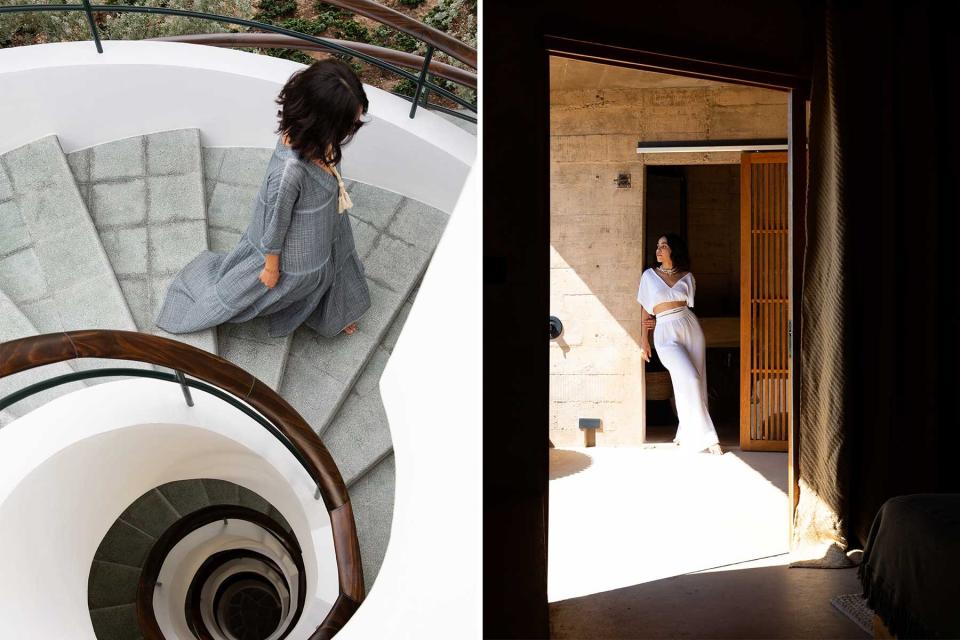Three New Hotels Putting a Luxe Spin on Baja's Adventurous Side

Skye Parrott The living room and central garden at Paradero Todos Santos.
On the first morning of my road trip through Baja California Sur, I found myself bobbing in a small boat off the coast of the state capital, La Paz. Pelicans skimmed the glassy surface. Dolphins made a frolicsome cameo alongside the hull, followed by dozens of stingrays, as if eager to flaunt the abundance of biodiversity that led Jacques Cousteau to christen these waters "the world's aquarium."
My affable guide, Said Estrada, who works with eco-outfitter Red Travel México, was confident that the windless morning meant we'd soon locate the largest known fish in the ocean: a whale shark. A generally elusive species, the speckled creatures can grow up to 40 feet long and congregate from late fall to late spring, when currents turn the area into a plankton buffet. Once we had spied a shark, we would dive in and, if all went according to plan, swim alongside it.
"You'll see," Estrada said, a proud lilt to his voice. "There is much more to Baja than being hungover in Cabo." He was referring to Cabo San Lucas, the rollicking resort town at the southernmost tip of the peninsula, and the reason the region lingers in many minds as one where spring break springs eternal.
My education in the limitations of such thinking had begun the previous day. After flying in to Cabo, I rented a car and headed north along the western flank of the 775-mile-long peninsula, which soon enveloped me in a sun-doused landscape of untrammeled splendor: cacti-dotted desert, jagged mountains, the emerald churn of the Pacific. Few cars, fewer people, no gaudy or glossy development.
The sensation of being transported to a time before civilization was so acute that it came as something of a shock when, 2½ hours later, I arrived in La Paz, a frenetic, industrious port city and marine biology hub that butts up against the arresting turquoise waters of the Sea of Cortés.
Ecotourism has for decades been the economic engine of La Paz, thanks to Espíritu Santo Archipelago, a unesco-protected marine park where the sea teems with wildlife. The accommodations have generally catered to those looking for fuss-free quarters after a day of snorkeling with sea lions. My lodging, the Baja Club Hotel, offered a glimpse into how the city, like the region, has been slyly evolving to attract travelers who crave off-the-grid enrichment and, increasingly, refined places to stay.

Skye Parrott. Model: Gaby Collado. Wardrobe: Courtesy of Nomad Chic, Todos Santos From left: The dining room at the Baja Club Hotel, in La Paz; the hotel's pool.
The 32-room property is the latest offering from Mexico-based hotel brand Grupo Habita, and is constructed around a restored early-20th-century hacienda that faces the promenade skirting the bay. As I walked through the hulking wooden doors, the bustle of lowriders and lifted pickups outside gave way to hushed, unexpected elegance: terrazzo flooring, a library, a glittering pool tucked away in an interior courtyard, a spa, and a rooftop bar. The overall impression was less hotel than the residence of an eccentric, seafaring poet with very cool friends and a sizable trust fund—a jolting contrast to the dusty roads I'd spent the day traversing. It seemed an improbable base camp for adventures like swimming with sharks.
An hour into my excursion, a fierce wind had picked up, ruffling the surface with whitecaps. After another sharkless hour, Estrada was getting edgy. Visibility was now limited, and new conservation initiatives aimed at protecting the ecosystem regulated the number of boats allowed on the water, meaning our allotted time was running out. When Estrada turned back toward the harbor, however, he suddenly became animated. He leaped into the water, calling for me to follow him.
As I attempted to track with Estrada in the currents, I felt something immense below me—a nudge, delicate and spooky, against my hip. When I looked down, my vision filled entirely with the spotted skin of a shark the size of a small submarine; its dorsal fin, we later decided, had most likely been what grazed me. After it passed, I caught a glimpse of its full form, majestic and aloof, before it vanished into the murky blue—a surreal, magical encounter that set the mood for the next few days.
Back on land, I drove in a reflective trance a few miles north of the harbor, through a mangrove reserve and past escarpments of pink-tinged rock. I'd hoped to spend the afternoon at Playa Balandra, a circular bay of white sands and shallow, crystalline waters that routinely tops lists of Mexico's most beautiful beaches. When I arrived, however, I was told it had reached capacity, according to local COVID-19 restrictions—a momentary pinch of disappointment that gave way, as so much does in Baja, to discovery.
Just a few minutes south, I pulled into Playa Pichilingue, a spit of bone-white sand where I managed to squeeze in under any entry caps as one of only about 10 people. The afternoon dissolved over cold beers and a medley of tilapia, octopus, and shrimp simmered in a smoky tomato sauce at La Luna Bruja, the beach's simple café.

Skye Parrott A guest room at Baja Club.
That evening, I took in the sunset from the roof of the Baja Club before wandering away from the main drag to get a sense of a town that feels built for actual living, rather than visiting. I stopped at La Miserable, an unassuming bar with a slapdash courtyard, for what I thought would be a quick cocktail. Instead, it turned into a languid, multi-hour affair thanks to my server, Attila Cocchi, a young, tattooed dude in a pageboy cap, who exuded laid-back warmth and insisted on giving me an extensive tutorial in mezcal.
"You know how you talk about the body of wine? Well, we talk about the legs of mezcal," he explained, noting that proper mezcal has a higher alcohol content than what's shipped to the United States. "The higher the proof, the better the legs. Good legs walk smoothly down the throat, while bad legs tumble down."
I tried many, perhaps too many: piney, ashy, bright, citrusy. On Cocchi's recommendation, I ambled a few blocks to Marinera Poke & Seafood, where the crudo of freshly caught albacore and the shrimp gyoza with miso butter once more reminded me that the city, much like the waters surrounding it, rewarded those willing to go beneath the surface.
There is a fantasy that, prior to this trip, had enjoyed heavy rotation in my personal daydream arsenal: driving down to Baja from my home in Los Angeles, getting lost and found, surrendering to vagabond clichés. Setting off the next morning into the interior of the peninsula, I got a taste of that experience as I drove through foreboding desert, where eagles and vultures circled overhead, before heading east into the Sierra de la Laguna on an adrenaline-spiking road of hairpin turns and hallucinatory vistas.
An hour and a half later, I was hugging the rugged coastline of the East Cape, imagining spending a few months living out of an RV under an assumed name—an admittedly absurd parallel life to be contemplating given that I was going to meet my girlfriend, Erin, at the Four Seasons Resort Los Cabos at Costa Palmas. Part of an ambitious development project, the hotel and golf club opened in 2019 and will eventually be joined by a new Aman resort, Amanvari. A marina, a yacht club, and lavish private residences are also on the way, turning this previously undeveloped stretch of coastline into a micro-haven for the jet set.

Skye Parrott The Four Seasons Resort Los Cabos at Costa Palmas has two miles of private beach lining the Sea of Cortés.
Located on eight acres, the Four Seasons is designed to feel like an oasis, with its tan, low-rise structures emerging, mirage-like, from sand dunes that have been impeccably groomed to appear ungroomed. Like all of the resort's 141 rooms, our suite offered an unobstructed view of the Sea of Cortés, which has calm, swimmable waters. In addition to the staff, who were seemingly telepathic, the sense of privacy was astounding. Though the resort was close to full capacity, we had the feeling of being marooned.

Skye Parrott The open-air lobby at the Four Seasons Resort Los Cabos at Costa Palmas.
In keeping with the spirit of Baja, the hotel encourages adventuring and arranges excursions as varied as hikes to a mountain waterfall, 4 x 4 off-roading through nearby dunes, deep-sea fishing, and snorkeling outings to Cabo Pulmo National Park, just south of the property. Erin and I opted for something mellower, a private sunset cruise, since our stay coincided with the annual migration of gray whales.
Though no whales surfaced as we watched the sky morph into a kaleidoscope of pale pinks, we delighted in a bottle of Moët Nectar Impérial—a decadent aperitif before dinner at Limón, one of the hotel's five restaurants. Tables are set amid a lemon grove, and the majority of the food, including cauliflower with serrano pepper and pork ribs slathered in a guajillo-chile purée, is cooked over a wood-burning grill.

Skye Parrott From left: The Four Seasons Resort Los Cabos at Costa Palmas; the “Baja seafood pineapple” at Casa de Brasa, a restaurant at the Four Seasons.
"What is that?" Erin asked the next morning, gesturing toward the ocean as we sipped coffee on our terrace, having sunk into a euphoric delirium. What at first looked like a fountain on the horizon turned out to be a rare, electrifying display of Mobula rays—hundreds, maybe thousands, tossing themselves gracefully into the air.
Heading out onto the beach to get a closer look at a phenomenon that remains mysterious even to scientists, we walked onto a stretch of white sand where the ocean meets a freshwater lagoon. Blue herons stalked the low tide, wild horses grazed under swooping fan palms, crabs skittered across the sand—nature reminding us of its irrepressible grandeur even in the most manicured of environments.
We crossed west through the mountains to spend the final leg of our trip near Todos Santos, a town on the Pacific coast that has become a haunt for nomad surfers, intrepid wanderers, and bohemian expats. Our destination: Paradero Todos Santos, a new hotel that celebrates this lifestyle with a level of stagecraft squarely aimed at seducing even the most seasoned of influencers.

Skye Parrott. Model: Gaby Collado. Wardrobe: Courtesy of Nomad Chic, Todos Santos Architectural details at Baja Club Hotel (left) and Paradero Todos Santos (right).
The approach itself felt cinematic, as we turned off the main highway and onto a dirt road, passing through farmland and fields of ancient cacti and into a compound of Brutalist concrete structures. The open-air lobby, with its minimalist furnishings and swooping hammocks, was referred to as "the community."
The outdoor spa, still being completed, included a temescal for various ceremonies geared toward spiritual cleansing. The half-moon infinity pool looked like it could double as a backdrop for experimental theater.
One of the staff members, all of whom floated about the grounds in alpaca ponchos and carried themselves with casual authority, led us to our room, a rooftop suite of earth tones that featured a "sky net"—a hammock on the top floor, meant to encourage nighttime stargazing.

Skye Parrott Paradero’s 35 suites are appointed with textiles and furnishings made by Mexican artisans.
"I have the feeling," Erin whispered, "that we're maybe being initiated into a wellness cult." Which, in some ways, is the point of Paradero, which bills itself as an "experience-inclusive" hotel. The activities-centric approach gives it the feel of a summer camp for grown-ups. Erin and I chose two of the more physically demanding options. Expecting the kid-glove approach often favored by resorts, we were impressed at the arduousness of the excursions. A half-day biking trip took us through small villages and up steep hills overlooking the ocean.
Surfing was at nearby Playa de Los Cerritos, where I paddled out on my own, watching Erin, an Iowan with an aversion to waves, catch a handful of grin-inducing rides with the help of her instructor, Martín Olea. These kinds of rugged outings contrasted with the experience of dining at the hotel—in the best way possible.
Chef Eduardo Ríos, formerly of Pujol, Mexico City's temple of culinary prowess, elevates open-fire cooking into the realm of high art. The shrimp zarandeados—four butterflied, shell-on prawns blackened to a smoky splendor—was the gastronomic highlight of the trip.

Skye Parrott From left: Chilaquiles rojos, a breakfast staple at Paradero; cocktails at the hotel bar.
Much as Paradero is a destination in itself, the property is also in a prime location for exploring the surrounding area. One afternoon, Erin and I drove back toward Playa Los Cerritos to Barracuda Cantina, where we devoured pilgrimage-worthy shrimp tacos on the vine-shaded patio. Another afternoon was spent bopping in and out of boutiques around town after sublime yellowtail tostadas and perhaps too many margaritas at Tiki Santos Bar.
On our last night, we drove down the main road, turning right at a small sign that simply read beach bar, which led us to Pure Playa, where firepits crackled as a DJ spun inoffensive electronica. After the sunset, we navigated the labyrinthine dirt roads to Hierbabuena, an unpretentious spot where most of the vegetables are harvested from the on-site organic gardens.
Driving back toward the airport the next morning, I couldn't help feeling a familiar sense of melancholy, wondering how long Baja California Sur could exist in the sweet spot I'd spent the week appreciating—gritty here, polished there, so distinct from Cabo.
These concerns quickly subsided when we pulled off on a stretch of coastline that was barren, save for a faded van that had likely been converted to run on vegetable oil or, for all I knew, pure karma. Out in the distance, we noticed something on the water—a solitary gray whale, breaching the surface, a small geyser erupting from its blowhole as it let out a primordial exhale. This Baja wasn't going anywhere—at least not anytime soon.

